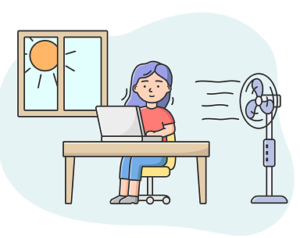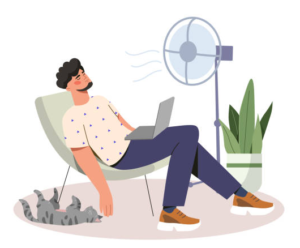It’s getting hot in here….how to help your employees through the heatwave
 As a nation obsessed with the weather, I predict that roughly every 5.3 seconds your employees say or think “ooofff its hot, isn’t it” or “I’ve heard it is hotter here than it is in Seville”! According to Google the search term ‘what temperature is too hot to work?’ has seen an epic spike over the last week.
As a nation obsessed with the weather, I predict that roughly every 5.3 seconds your employees say or think “ooofff its hot, isn’t it” or “I’ve heard it is hotter here than it is in Seville”! According to Google the search term ‘what temperature is too hot to work?’ has seen an epic spike over the last week.
While there’s no guidance on maximum temperature limits in the workplace, gov.uk states that all UK work environments must ‘keep the temperature at a comfortable level’ to adhere to health and safety at work laws. The Trades Union Congress has called for a maximum temperature to be instated – of 30 degrees for indoor work, and 27 degrees for strenuous work.
If you or your staff are struggling to stay motivated in the heat, HR Optimisation provides a few suggestions to help you below to help your teams be more comfortable during heatwaves, and ensure you don’t suffer as a result of the weather:
Consider a change in dress code
The Health and Safety Executive states that ‘wearing too much clothing may be a primary cause of heat stress,’ though ‘many companies inhibit the ability for employees to make reasonable adaptations to their clothing.
If you have an informal or formal dress code in your office e.g. that typically adopts a “jacket and tie” or “no shorts rule” or “no open-toe shoes” then consider if this is absolutely necessary at all times or if this can be relaxed or all or some workers when temperatures reach certain levels. Also if you have field workers who require PPE, is there lighter, heat deflecting options you can provide them? Do they need a cap to deflect the sun’s heat from their heads for example. Chat to your employees and find out if they are uncomfortable in the usual workwear provided.
Keep the temperature in check
Whilst there is no official maximum legal temperature, as an employer your responsibility to provide a comfortable working environment, and your employees will work more productively if they are comfortable. That means ensuring that the temperature is ‘reasonable’ in order to meet the requirements of UK health and safety laws. Ensure you are able to monitor the temperature in your office, and provide aircon or fans to help provide air circulation relief if the Celsius is high. Shut blinds or curtains to avoid direct sun glare. Consider a trigger point to send people home/home early and ensure this is known to your line managers
Consider flexible working
Even if you have taken the correct measures to ensure your workplace is comfortable e.g. with aircon, you may still find employees struggling with the temperature and their commute. If flexible working is not already a regular option, why not consider it during the summer months? This might mean a working from home policy, or it could be a change in start and finish times, enabling employees to travel and work during the cooler periods of the day.
It is not uncommon for train services to become delayed or cancelled in hot temperatures due to the lines buckling in the heat. If employees have the option to work from home, this may be an alternative if transport difficulties mean they cannot get into work. Otherwise consider allowing employees to make the time up for any lateness caused by transport problems, or perhaps allowing them to use holiday if they know they will not be able to make it into the office.
Encourage more breaks
Even employees who love what they do, can find spending eight hours a day in a hot, stuffy office leaves them feeling exhausted. Encourage your employees to alter their routine, to spend more time outside during the day getting some valued vitamin D and/or breeze such as by splitting the lunch hour into 5 15 minute breaks to cool down and clear their head.
Alternatively, if there’s an outdoor area or cooler inside spot to work, you could promote this as a space for employees’ to work in or encourage them to hold their meetings in.
Ensure adequate support
During the summer months, many of team members head on holiday so it is important to make sure that those left holding the fort are supported enough and given as much advanced planning as possible to accommodate the additional work needs. If they are needed physically in the workplace, make sure this is not an arbitrary rule and there is a genuine reason for them to be there.
Employers should also take extra care to protect any vulnerable people in the office. Hot weather can make people feel tired and less energetic than usual, especially for young and elderly people, pregnant women, and people who may be on medication or fasting. Ensure you or your managers check-in with vulnerable people in your office who may appreciate extra rest breaks or a desk fan to improve air circulation for example.
Cool down treats
For non-dispersed colleagues, why not treat them to a cool down treat such as an inexpensive chilled can of softdrink/beer or a selection of ice lollies to help bring the chill to their work day; as well as boosting engagement it will also genuinely help cool down the heat. Other employers I know provide ice and squash to help refresh, whilst others go the full hog and also put water games on their roof terrace including a foot paddling pool to help people stay cool as they make the most of their sunshine breaks.
How is your workplace coping with the heat? Have you changed your work routine to manage the hot weather? We’d love to hear all about it hello@HROptimisation.co.uk .
Categories
- Coaching (9)
- CSR (1)
- Culture (1)
- Culture & Engagement (33)
- Diversity and Inclusion (16)
- Employment law (38)
- Inspiration (12)
- Leadership (14)
- Learning & Development (7)
- Recruitment (12)
- Reward (9)
- Self-development (2)
- Tips & tricks (11)
- Uncategorized (18)
- Welfare and Wellbeing (26)
